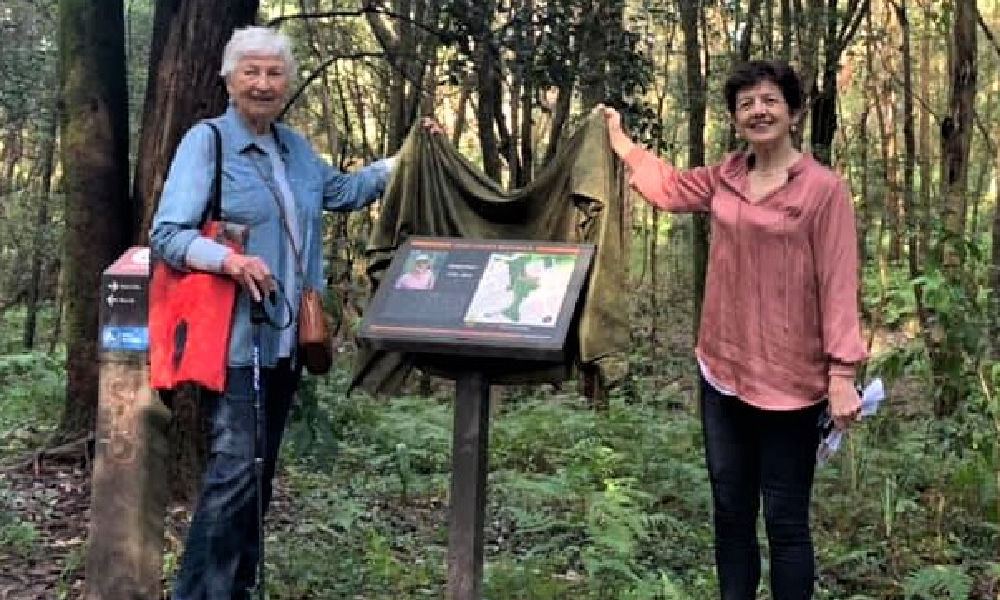Almost every part of Lane Cove is within 500 metres of bushland and the efforts of the Lane Cove Bushland & Conservation Society have helped to preserve this vital urban bushland. Recent events such as the pandemic lockdowns and the threat of climate change have helped us truly recognise the value of this land for both human and environmental sustainability. The Society celebrated its 50th Anniversary last year.
The Lane Cove Bushland & Conservation Society provided ITC with details about their 50 years of work protecting Lane Cove bushland.
The society would love more residents to help with the ongoing work of protecting local green heritage from encroachment by overdevelopment and to combat climate change.
The Society also organises bush walks and plant sales. Get involved and protect Leafy Lane Cove. Please go to their Website to join.
It All Began in 1971
Our history dates to 1971 when attitudes to nature were changing and pockets of bushland in Lane Cove, previously used for dumping rubbish, were beginning to be appreciated for their plant and animal life. Brian Patterson an English Biochemist newly arrived in Lane Cove, reportedly said, “there were more species of indigenous plants within a 20-mile radius of Sydney than there were in the whole of the UK.”
When an extension to the Lane Cove Golf Course was proposed that would push into the bushland at the eastern end by the 9th hole and fill the Gore Creek Valley with rubble, mothers and children confronted the bulldozers. One bulldozer driver told Jan Craney, standing in front of him with her two children, that he had insurance to drive over anyone.
The Gore Creek valley had been granted to Lane Cove Council in 1948 by F. E. Cogan in return for a development approval in the surrounding area. Council had leased the bushland to the Lane Cove Country Club but when the extension was proposed, only Cogan could bring an injunction to prevent it but he wouldn’t finance the court case. A newly formed society, the Lane Cove Preservation Society, raised the money to support the legal case with a very successful Arts and Crafts Fair. Such was the publicity and outcry that Council finally settled out of court.
In 1972 the Lane Cove Preservation Society changed its name to the Lane Cove Bushland & Conservation Society, including ‘Conservation’ to reflect the wider range of environmental interests and activities both locally and nationally in relation to climate, waste management, toxic chemicals, transport and development. The area at the end of the golf course was formally declared the Lane Cove Bushland Park in 1980, a wildlife refuge under National Parks &Wildlife Service of NSW, and is managed under a plan largely informed by the Lane Cove Bushland & Conservation Society. It was listed on the National Estate in 2000 when then Society members, Ray and Elma Kearney, discovered Hygrocybe fungi, some 9 of the 30 species of which were found to be endangered.
Remembering Doug Stuart
In May this year a ceremony was held in the Bushland Park with Mayor Pam Palmer and founding Society member, Norma Stuart, to name a walk in honour of the memory of Doug Stuart, Norma’s husband. Doug was a founding executive member of the Society who, over his lifetime, made a great contribution to the preservation of the natural environment of Lane Cove. Beginning in the summer of 1971-72, Doug Stuart organised a large team of volunteers to survey the condition of all Lane Cove’s bushland to identify sites suitable for regeneration. He drew maps of each site, checked ownership and created the first cohesive document the Council had ever had.
Following nearly 20 years of lobbying, research and education by Society members, the Council’s Bushland Plan of Management was approved in 1990 and a committee, the Bushland Management Advisory Committee (BMAC), was established. As well as community representatives, there are three representative places dedicated for members the Society. As Rod Tudge, former Lane Cove Mayor and Society member said in a speech celebrating the 25th Anniversary of BMAC, “The Bushland Management Advisory Committee didn’t just happen, it was a concerted effort by a number of people over many years.” At the same celebration the Mayor, the late Deb Hutchens, acknowledged the importance of the Council’s partnership with the Council’s Advisory committee.

Working with Lane Cove Council
The Society has worked with and lobbied Council. We canvass Council candidates for their commitment to the environment and more than 25 Society members have served on Council: Rosilyn Baxter was on Council for 21 years and served as Mayor for part of that time, Bill Henningham and Rod Tudge were also Mayors; Frances Vissel is currently a Councillor and our President, Shauna Forrest, has been a Councillor. In 2017 we actively campaigned against amalgamations in the Council elections and canvassed candidates for their position in relation to merging with Ryde and Hunters Hill.
Popular Native Plant Sale
Perhaps the most visible activities of the Society are the native plant stalls held in the Plaza and our bushwalk programs. The native plant stalls, which provide advice on growing plants indigenous to Lane Cove, have been held since 1975 in Spring and Autumn and are presently organised by Ruth Neumann. The Society has assisted in the publication of a number of books which are available on the stall, including Growing the Native Plants of Lane Cove by Judy Messer, which can also be downloaded from the Council website, and the history of the Society, Beyond the Untidy Fringe by Virginia Macleod, which was published by Lane Cove Library in 2012.

Guided Walks
From the start, guided walks have been a way the Society informs people about bush preservation and regeneration. Ron Gornall, a long-term executive member, a past president and plant expert, has guided regular Spring wildflower walks with Barbara Gornall on North Head Sanctuary, Manly. Our new bushwalks team, Kate Moppett, Leon Horsnell and Linda Falardeau, have prepared more local walks in local reserves, guided by plant experts. Details can be found on our Website: https://lanecovebushland.org.au/ and Facebook page: https://www.facebook.com/LCBCS/

Several of the Society’s earliest members were active bush regenerators and the management and conservation of the bushland is a central and ongoing concern for the Society. Society members and botanists, Doug Graham and Dr Don Adamson, reported on how to manage weeds, and later the Noxious Weeds Board was lobbied by the Society’s President to focus on urban as well as agricultural weed threats. The Society is sometimes confused with the Bushcare Program and although we share common aims, the Society remains an independent not-for-profit organisation which, from the beginning has addressed wider environmental issues.
In 1981 Stringybark Creek Bushland and residents were threatened with toxic spraying due to the discovery of Argentine Ants, and the solution proposed by the Argentine Ant Eradication Committee (AAEC) was to spray the area with carcinogenic chemicals. Society member Herbert Beauchamp, an industrial chemist, together with campaigner Dr John Pollak and Milo Dunphy formed a ‘Toxic and Hazardous Chemicals Committee’ at the highly respected Total Environment Centre. Joe Vissel, supported by the Society, took out an injunction against the NSW Minister for Agriculture to forbid spraying which was upheld in the Land & Environment Court in 1983.
Lane Cove has seen enormous changes in population and increased housing over recent decades. Early in the 1990’s the Society was invited by Council to comment on developments adjoining bushland. This has led to monitoring Development Applications by Society members, led particularly by Doug Stuart and Graham Holland, both of whom were architects, for compliance with regulations relating to density, floor space ratios, deep soil planting of trees, setbacks from bushland and development potentially damaging to the environment. As Jack Mundey of the Builders Labourers Federation said in reference to the preservation of the Rocks area in 1973, “Those of us who build must be more concerned with what we build. The environmental interests of 3 million people cannot be left to developers and building employers whose main concern is making a profit.” In recent years Society members have made submissions concerning the Lane Cove Golf Course, the Data Centre on Mowbray Road and a number of aged care facilities that border on and often negatively impact public open space and bushland, in order to protect native habitat and threatened species.
Lane Cove Bush Kids
In 2011 three mothers, Corinne Fisher, Ann Proudfoot and Alyson Hayes, all members of the Society, founded the award-winning Lane Cove Bush Kids program to engage young children and their families with nature. It was so successful that the Society partnered with Council in 2016 to further develop and run the very popular program and employ a coordinator, Valerie Holland.
Other issues addressed by the Society include campaigning for legislation against the single use of plastic bags and lobbying Council and in the media for recycling schemes.
Protecting Urban Bushland
In 2014 legislation was introduced as a bushfire safety strategy to allow trees 10 metres and vegetation 50 metres from a home to be cleared without approval or species identification. It was known as Code 10/50 leading to disastrous felling of mature trees, and members of the Society protested outside the then Deputy Premier and Willoughby MP Gladys Berejiklian’s office. The Society successfully lobbied local State members Anthony Roberts and Gladys Berejiklian to have the Code modified to be suitable for urban bushland environments.

Specific issues such as these have led to the founding of sub committees that became independent groups. Corinne Fisher was the first Convenor of the Better Planning Network in reaction to NSW planning legislation introduced in 2013. The Lane Cove Coal & Gas Watch was originally founded by Sally Kennedy who received the Nature Conservation Council’s Environment Award in 2014 and the Lane Cove Citizenship Award, 2017, in recognition of her contribution to the community life of Lane Cove and environmental conservation.
We need residents to help us with the ongoing work of protecting our local green heritage from encroachment by overdevelopment and to combat climate change. Please go to our Website and join us. https://lanecovebushland.org.au/
The statement made in 1980 by past president Doug Graham is still so relevant today:
‘Now that the Lane Cove Council is generally sympathetic to environmental matters ….there is a tendency to think we can sit back and relax. Such complacency must be avoided.’
Help Support Local and Independent News
You can support us in three ways:
- Become an ITC reader sponsor – Feel free to be a reader sponsor if you have enjoyed our local news coverage and would like to be an ITC reader sponsor. You can sponsor us with a monthly sponsorship fee. We have reader sponsors who sponsor us for $5.00 a month and some who sponsor us for $100 a year – no amount is too small or too big. Thank you so much to the people who have already supported us via our press Patreon account. Help Us Here.
- Buy the ITC team a coffee – We now have a team, and they need to be paid – buy the ITC team a coffee (or two) and that will help us pay their wages and shout then a coffee Buy a Coffee here.
- Do you own a Lane Cove Business or a Lane Cove resident who owns a business, you can advertise with ITC – our packages start from $30 monthly fee (for a 12-month commitment). Email us here for our rates card.













